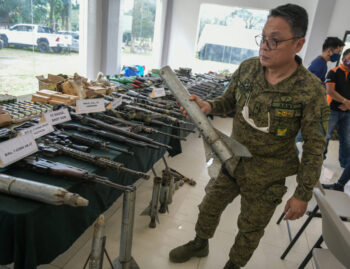
DAVAO CITY (MindaNews / 21 August) — We are staying in an old hotel by the coast. One likes the wide and green open space. Its serenity suits one’s introverted nature. Nature’s lullabies are everywhere. One wakes up to the soothing sounds of birds and falls asleep to the balmy swaying of palm trees. The natural sounds are occasionally broken by the morning chores of the sanitation staff, and in the afternoon, as the sun is about to set, by families cheering on newlyweds. Hurrahs fill the air as families reunite, their last name prominently displayed on the back of their shirts. Additionally, high school friends gather for the nth time, joyfully reminiscing about their active younger days.
It did not take long before some of my colleagues began discussing eerie topics – vague sightings, shadowy figures, and ethereal whispers. As Filipinos, one could argue that it is ingrained in our culture. Aging houses, expansive properties nestled in nature, and especially abandoned or old sites, tend to trigger our vivid imaginations. Behind a balete tree exists a distinct entity, while a massive talisay tree houses another kind entirely. Unseen beings also inhabit specific rooms or linger in various corners. Over the years, diverse forms of unseen entities have developed, captivating our collective imagination.
Room 204 became the focal point of our conversation, as several of my colleagues began sharing their paranormal experiences. These accounts ranged from hearing the eerie creaking of the wooden floors and ceilings to seemingly overhearing hushed conversations despite no one else being in proximity. The room’s history included reports of a chilling demise, with lingering rumors suggesting that the ghost of the deceased woman is still roaming, serving as a haunting reminder of the justice she was purportedly denied. Perhaps her spectral presence sought aid or closure, further adding to the enigmatic aura surrounding this hotel room.
I did my utmost to refrain from listening, as I had imbibed a crucial lesson from my elders during my early years: the more attention and credibility one bestows upon something, the more it gains legitimacy and reality. Doesn’t this align with Murphy’s Law?
Furthermore, both my religious and cultural traditions encompass a belief system concerning “unseen beings” and their parallel existence in a realm alongside ours. Generally, these unseen beings mirror our world, encompassing a spectrum ranging from the benevolent to the malevolent. Comparable to the perpetual struggle between good and evil, an ongoing conflict between the practitioners of white and black magic also exists, involving a constant battle of offense and defense.
The Sama tradition in Tawi-Tawi is rich with unseen beings, many of which synthesize elements from both our pre-Islamic and Islamic psyche. Central to Sama beliefs is the concept of parallel worlds: the realm of the living and the realm beyond. This belief gave rise to two distinct forms of traditional craftsmanship. The first one transformed into “pagtambal,” which literally means “to cure.” Pagtambal represents the art of curation, acknowledging the existence of malevolent entities whose harm can be alleviated, prevented, warded off, channeled, or ultimately cured through appropriate “tambal” or treatments.
The “ananambal” (healer), the individual responsible for conducting these treatments, possesses an arsenal of remedies that range from the simple “tawal” (oral incantation) to more intricate ritual practices. These rituals can take place either at the home of the affected person, in a “tampat” (shrine), or, in the case of Sama Tabawan, at one of their traditional “luma’ maheya” (big houses). Rituals that require more time for healing are often performed at the healer’s own residence, where they have easy access to their paraphernalia and herbal medicines.
Irrespective of the ailment afflicting an individual or the complexity of the treatment administered, the overarching goal of the “pagtambal” (healing) process remains consistent: to reinstate equilibrium. This process serves the dual purpose of safely guiding the living individual back to their designated space while also assisting the unseen beings in returning to their rightful realm.
From simple to more complex healing rituals, there is always a gathering for “dua salamat,” which is a thanksgiving ceremony that formally marks the transition of care for the affected person from the healer back to their family.
Additionally, the “ananambal” holds a position of high respect within the community and is distinct from other traditional practitioners, including the “imam” (who leads prayers in the mosque), the “hatib” (responsible for delivering the Friday sermon), the “angungubul” (tasked with burying the deceased), the “tukang magsugsug-tawbat” (an expert in conciliation), the “jaga tampat” (a shrine watcher), and the “panday” (traditional midwife). The healer is believed to possess innate gifts or connections with unseen beings, who collaborate to achieve desired outcomes. Some of these unseen beings offer assistance as a gesture of gratitude for past interventions, while others anticipate reciprocation for the services they provide.
Furthermore, the healer may prescribe various protective items such as the “ajimat” (a charm with Qur’anic verses wrapped in cloth), “hampan” (a charm sewn into a small bag or belt worn around the waist), the “baklaw” (a knotted cord tied around a child’s neck), the “sulaw” (a bracelet crafted from a cross-section of a cone shell designed to shield the wearer from paranormal entities), and the “gampang” (offering protection against sorcery of a sexual nature for females), among others. These items collectively serve as shields against potential future paranormal threats.
While the first form revolves around the concept of “pagpahap” (balancing, helping, and reconciling), the other manifestation of traditional craftsmanship is known as “maghinang-hinang” (creating something or scheming, in a literal sense). This form carries a more sinister nature (“laat akkal,” malevolent in nature), as it taps into primal desires. It encompasses an arsenal of schemes, tricks, and deceptions employed by the “aa ngahinang” or “aa ngahinang-hinang” (someone who crafts harm or schemes against others; figuratively, a sorcerer). In contrast to the healer who is held in high regard and affection, the sorcerer evokes fear due to the veiled nature of their powers and the unpredictability of their intentions. Typically residing on the outskirts of the village, the sorcerer is actively avoided by the locals. Only those with specific dealings with the sorcerer muster the courage to traverse the path to their dwelling.
Among past experiences, certain practices have included the use of love potions and charmer’s smoke aimed at manipulating romantic feelings. Instances have arisen where individuals struggling to manage their desires for a specific person sought the assistance of sorcerers, resorting to extraordinary means to gain their affections. Unrequited love has driven some to consider these avenues. Similarly, situations have arisen where individuals have sought help to address their partner’s promiscuity, attempting to regulate their urges. It is worth noting that even substances like food and drinks were not always safe from potential dangers in these contexts.
On a Friday night, when the full moon graces the sky, sorcery reaches its zenith, and its effects are at their peak. Throughout my upbringing, even in the heart of downtown Bongao in the 80s, the air would be filled with the sounds of people crying, wailing, shouting, and sobbing – all victims of the potent influence of sorcery.
Families impacted by this malevolent force would stay awake through the night, futilely attempting to provide solace to their afflicted loved ones, as modern medicine proves powerless in the face of sorcery’s apex. They would spend their nights awake, trying to console their afflicted members, seeking to alleviate their suffering.
As the night unfolds, neighbors huddle in fear, their thoughts silently reminding their own kin to exercise caution and vigilance, in order to avoid falling prey to the clutches of sorcery’s treacherous grasp.
Nowadays, the growing influence of Islam, modernity and globalization have resulted in the waning of these traditional crafts, especially black magic and sorcery. Some elements of traditional medicine, spiritual healing, white magic, and other forms of beneficial and positive spiritual or supernatural practices, especially those allowed within Islamic theology or consistent with Prophetic Medicine (Tibb al-Nabawi), continue to be observed and thrive. Our “ulama” (religious leaders) remind us that the best safeguard against the potential harm from the unseen beings – or black magic and sorcery – is to strengthen our faith and seek protection through constant remembrance of Allah.
We conclude this article with Surah Al-Falaq (Chapter 113), a concise chapter from the Qur’an that conveys a profound message of seeking refuge and protection from various forms of harm, particularly those stemming from unseen forces and negative influences. Within this surah, we are advised to seek refuge in the Lord of daybreak, acknowledging the Creator’s omnipotence over all things. The guidance is to seek protection from the detrimental aspects of creation, whether they manifest as supernatural entities or negative energies, in order to shield ourselves from the harmful forces that might arise during moments of darkness and obscurity, symbolizing instances of vulnerability. The surah directs us to seek refuge from those who engage in such actions, referred to as “blowers in knots.” Envy often gives rise to negative intentions and actions aimed at causing harm to others. By seeking refuge from the malevolence of an envier, we underscore the aspiration to be safeguarded from the malicious intentions of those who harbor jealousy and negativity.
Say:
“I seek refuge in the Lord of daybreak
From the evil of that which He created
And from the evil of darkness when it settles
And from the evil of the blowers in knots
And from the evil of an envier when he envies.“
— Surah 113: Al-Falaq, Holy Qur’an (Saheeh International)
(MindaViews is the opinion section of MindaNews. Noor Saada is a Tausug of mixed ancestry—born in Jolo, Sulu, grew up in Tawi-Tawi, studied in Zamboanga and worked in Davao, Makati and Cotabato. He is a development worker and peace advocate, former Assistant Regional Secretary of the Department of Education in the Autonomous Region in Muslim Mindanao, currently working as an independent consultant and is a member of an insider-mediation group that aims to promote intra-Moro dialogue.)







